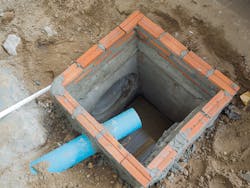Ever have one of those jobs where no matter how hard you strive, it’s just not going to go as planned? Even when if it’s not your fault, it still is?
We were just one piece of the puzzle, albeit the keystone. The challenge for the engineer, was designing a sewage pump system that could handily move the slurry from a pump-tank to the street where the discharge would connect to the township’s municipal sewage system — a distance of 2,850-feet through 2-inch HDPE piping.
Our job was to tie the existing 4-inch PVC building sewer line connected to the on-site septic system into the 8-foot deep cylinder (part of the dual grinder pump package system) and then connecting to the 2-inch HDPE pipe. We were also to install two three-phase 4-HP grinder pumps on slide-rails for ease of future service. Before ordering, we checked the voltage across terminals 1-2; 2-3; and 1-3 and provided that information to the distributor — just a wee bit over 200V. The control panel was to be located a bit more than 100-feet away on the building’s exterior with the three-phase and low-voltage floats wiring separated in separate PVC conduits.
The manager of the complex requested we install a branch with valves so that they could switch back to their septic tank if any problems developed with the new grinder pump system. In order to keep that as compact as possible, we installed two slice valves.
The first issue arose because the discharge fittings shipped for the grinder pumps did not match the pitless adapters; they were 2-inch instead of the 1½-inch required. When the two grinder pumps were installed, they tripped out on overload due to the low voltage. They were three-phase 4-HP 230V models. When I questioned the supplier, they admitted they made a mistake and that we should have been sent 200V models.
Catch 22: in order to determine the head loss through the 2-inch HDPE piping, you must first know the GPM flow rate!
Although specified by the engineer, I thought it important to determine if the TDH (Total Dynamic Head) was within the grinder pump’s rating of 120-feet TDH. TDH is the combination of static head — the change in elevation of 45-feet in this case; the head loss for the check valve, 90-degree ells, and tee each pump sees in its discharge line was 76.5-feet according to my calculations; and the head loss for the 2,850-feet of 2-inch HDPE pipe.
Catch 22: in order to determine the head loss through the 2-inch HDPE piping, you must first know the GPM flow rate! No one was able to determine that — including the grinder pump manufacturer. Another much easier method would be to install the grinder pumps, run each one for one minute, and measure the change in depth to the sewage in the tank.
The tank is 36-inches in diameter, so the old-school method is p ×(r) × (r) where p = 3.14 and r = 18-inches. So 3.14 × (18) × (18) = 1,017.36 square inches of surface area. Multiply that by 12-inches to obtain cubic inches per foot of depth = 12,208.32 cubic inches volume in 1-foot of depth. There are 231 cubic inches in one gallon of water. 12,208.32 ¸ 231 = 52.85-gallons per foot ¸ 12 = 4.4-gallons per 1-inch of depth. Or you can go to this engineering toolbox link: http://www.engineeringtoolbox.com/cylinder-volume-d_364.html, which is faster and easier!
On the first pass, we only recorded 1.75-inches or 7.7-GPM, which we felt was too low. We also discovered the control panel had incorrect overload safety switches — yet one more delay due to a problem from our distributor! Correct switches were installed. Reversing any two legs on three-phase power reverses the motor’s direction of rotation and after doing that, we recorded a depth change of 7.5-inches × 4.4 = 33-GPM. Pumps will pump in reverse rotation, but not as well.
According to the HDPE flow chart, we should see 2.0-feet of head loss per 100-feet. 2 × 28.5 = 57-feet of head loss. Adding static 45-feet + fittings 76.5-feet + the HDPE 57-feet = 178.5-feet TDH. The grinder pump curve indicates a max TDH of 120-feet and a no-flow condition at that point on its chart. Evidently the math suggested for determining head losses is a bit conservative because the actual flow of 33-GPM lands you at 102-feet TDH on the pump manufacturer’s chart. That’s well within the pump’s curve and moderately above the ideal 88-feet TDH the engineer had calculated for the pumps’ performance.
Snake bit! Thinking we’d finished the job, slice valves were switched from septic to grinder pump station only to discover the pumps would not turn off. Good grief: the brand new #4 float switch was defective and was replaced the following day. Never in my wildest imagination did I think we would need to install the slice valves because I believed the grinder pump station and its control panel would operate flawlessly so that this complex, that’s open to the public, wouldn’t have to close. Absent the slice valves, they would have either had to close or bring in porta-johns and you-know-who would have been stuck with that bill!
Dave Yates material both in print and online is protected by Copyright 2017. Any reuse of this material (print or electronic) must have the express written permission of Dave Yates and CONTRACTOR magazine. Please contact via email at [email protected].
About the Author
Dave Yates
Dave Yates material in print and on Contractor’s Website is protected by Copyright 2017. Any reuse of this material (print or electronic) must first have the expressed written permission of Dave Yates and Contractor magazine.
